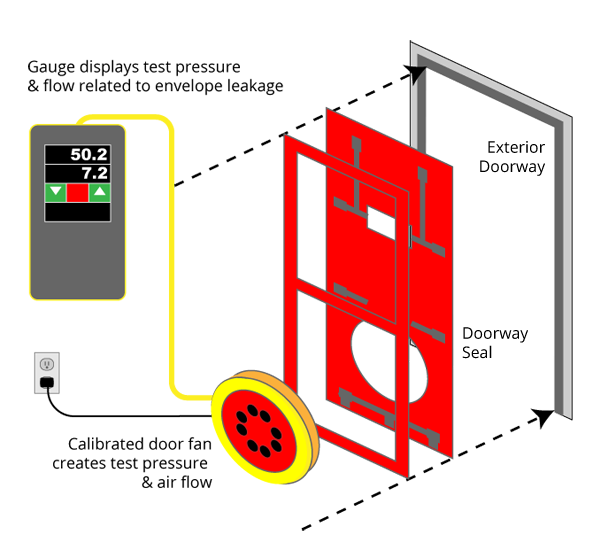Why Test the Building Envelope?
Air leakage is responsible for as much as 30% of all the energy lost in a building. The average building has enough air leakage to add up to a two-foot-square hole, the equivalent of leaving a medium sized window wide open 24 hours a day.
Ready to order?
Begin Blower Door Test Order
Advantages of Blower Door Testing
Finding and addressing leakage is often the least expensive way to save that energy. A Blower Door test can also identify potential safety, air quality and moisture problems before they happen.
To be Florida Code compliant, A blower door test must be conducted and passed on new residences before the Certificate of Occupancy (CO) will be issued. The International Energy Conservation Code allows either a Blower door test to prove adequate air tightness, or a visual inspection by the code official of a list of seventeen or more air barrier and insulation components. A Blower Door test takes about 30 minutes to setup and run, plus some time to measure the conditioned volume of the house, but the inspection can take much longer. Generally building officials prefer the blower door test because either it passes or fails.
Pre-Test Requirements
- House is complete and move-in ready, power must be on
- If attic is not sealed with open or closed cell foam, seal all penetrations entering attic: electric wires, can light or ceiling fixtures, plumbing lines, HVAC registers
- Weather stripping installed on all windows & doors
- Seal all penetrations made to the exterior walls: cable or ethernet lines, HVAC lines, Gas lines, plumbing lines, electrical lines/ conduit, etc.
- If possible, install gasket at Attic hatch cover
- Fireplace damper installed and operational
- Clothes drier vent backdraft damper operational
- All windows and doors closed and latched, none broken
- HVAC air handler fully installed
How does a Blower Door work?
A calibrated fan is mounted in an exterior doorway and blows air into or out of a home. The fan creates a test pressure of 50 Pa (similar to a 20-mph wind) which is displayed on Channel A of the gauge. Channel B displays the pressure signal from the fan which may be displayed as CFM or air changes per hour, depending on the selection made on the Mode key.

How tight does the envelope have to be?
The building must have 7 Air Changes per hour at 50 Pa (7 ACH50) or less to pass the2009 IECC. ACH = Air Changes per hour—a measure of how many times the air within the conditioned space (normally a house) is replaced, given the amount of flow measured and the volume of the space. Measuring Air Changes per hour requires the measurement of the test airflow in CFM required to achieve 50 Pa and the building volume. CFM = Cubic feet per minute—measurement of volumetric flow rate related to envelope leakage.
Solve Blower Door Test Failure Problems
The Energy Calc Services team will quickly find and seal all problem areas. Using fully approved and/or specified materials, our Techs have the experience to trouble shoot and seal any facet of your building.
To schedule sealing, give us a call!
